The 4 Types of Competitors You Need to Monitor

I’ve said it a million times before, and I’ll say it again: Your business does not exist in an isolated bubble.
Every business out there is constantly impacted by a number of different factors, including changes in consumer behavior, new pain points that cause new needs, and even economic shifts. One of the most significant factors that can impact your business is the competition that you’re up against.
Competitor research and monitoring are essential if you want to be successful. You need to stay on top of new features, product updates, and pricing strategies that could snag customers— existing and potential!— away from your brand.
Many of our readers know this already, but we’ve found that they’re typically focusing exclusively on direct competitors.
There are actually four types of competitors you’ll need to monitor, however, and in this post, we’ll look at each type and how to track them effectively.
The 4 Types of Competitors You Need to Track
There are three types of competitors that are primarily going to be threats and one type that could actually benefit you if leveraged correctly.
This chart breaks down the three types of business competitors that can have detrimental impacts on your brand, assessing competition based on company compatibility and customer overlap:
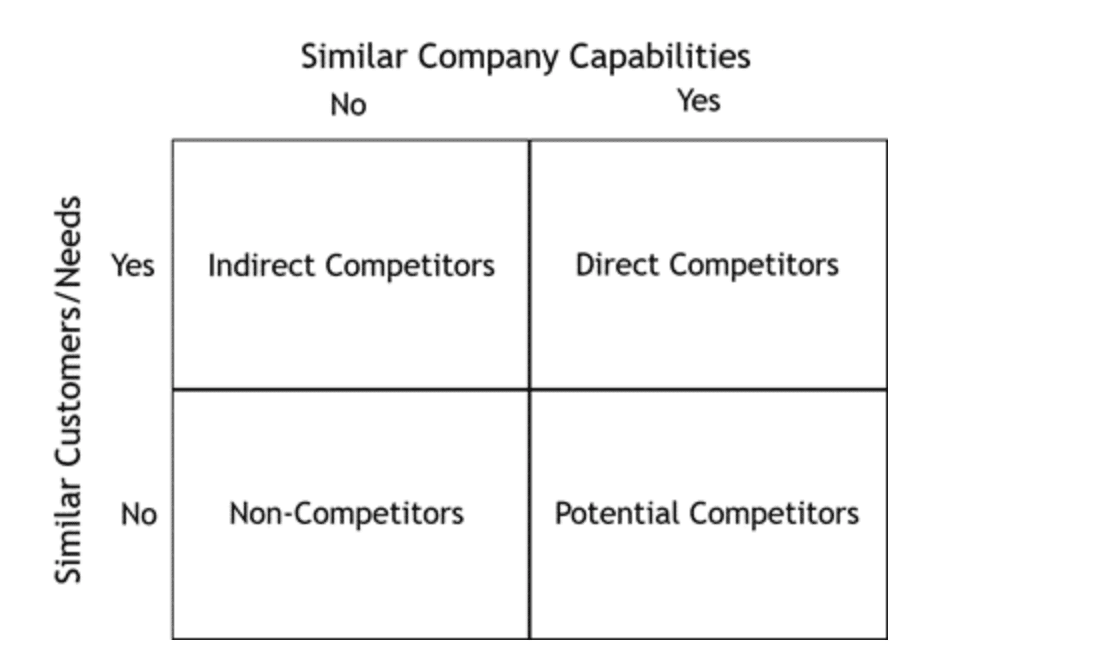
Brands that are serving similar customer needs and that function in a similar way are, of course, going to be your most direct competitors.
Those who may function differently but still address similar customer needs (like the brand that sells scent diffusers but not candles) will be indirect competitors.
Those who offer similar products but don’t target the same customer needs could be competitors, but might not be.
Brands who don’t serve the same customer needs and who don’t offer similar goods or services are typically non-competitors… though we’re going to put an asterisk by that. If they’re targeting the same media space and keywords online, for example, they could be competitors… and potential partners.
Let’s take a look at each of these types of competitors in more detail.
1. Direct Competitors
Direct competitors are those competing for your same audience and that offer similar products or services.
Let’s look at Quickbooks, for example, which is one of the most popular invoicing software on the market.
They target small and large business owners alike, offering invoicing, finance tracking, credit card processing, tax information, and more.
Freshbooks is a direct competitor. They also offer invoicing software to a variety of different business sizes, with many similar features, including invoicing, finance tracking, credit card processing, and tax information.
Freshbooks can successfully cost Quickbooks a customer, especially during the research and consideration stages.
2. Indirect Competitors
Indirect competitors are going to target similar customer needs, but with different capabilities.
A great example of an indirect competitor of Quickbooks would be PayPal.
PayPal is a payment processing platform that can be used for both personal and business use.
You can send invoices through PayPal, but it doesn’t have the same kind of extensive options that the other platforms offer in terms of payment options. They also don’t have expense tracking features, though they do offer business loans to qualified applicants.
Some freelancers, for example, do choose to send invoices exclusively through PayPal, forgoing paying the cost of invoicing software altogether.
3. Potential Competitors
Potential competitors have similar company abilities but are serving different customer needs.
An example of a potential competitor for Quickbooks may be a site like Upwork. Freelancers are just one segment of users Quickbooks may be targeting, and some freelancers may choose to use Upwork to find work and automatically invoice for it upon completion.
While Upwork is often preferred on the client’s side and would not be an invoicing solution most freelancers would seek out, it prevents those particular customers from needing an invoicing tool.
4. Competitors That Could Also Be Partners
While you may not think to get buddy-buddy with competitors, there is a unique niche when it comes to the type of competitors that can also be partners.
This is the case when you’ve got another business competing for the same media space as you, but that isn’t competing with you from a business perspective. They’re only competing from a marketing point of you to reach that same audience, but if you leverage that well, it can work to both of your benefits.
If Quickbooks targets keywords related to financial advice, they’ll compete with companies like Lending Tree. Lending Tree provides financing options for both personal and business purposes, so they’re not a direct competitor to Quickbooks outside of that marketing space. They could, however, team up to create a powerful partnership.
4 Ways to Identify Every Type of Competitor
Knowing how to identify every type of competitor— and not just direct competitors— is an essential part of competitor analysis and research.
With the right strategies, creating an accurate and thorough list of different competitor types becomes much easier.
There are four effective ways to find every type of competitor. Let’s take a look at each.
1. Know Who Your Audience Is
Getting a firm understanding of who your audience is will always be a crucial part of competitor research, so it’s going to be the first step here.
Ask yourself the following questions:
- What are your known and desired audience segments? What kinds of users are they made up of, and what are they purchasing?
- How do different segments use your product, or what are their motivations behind purchasing?
- What prohibits people from becoming customers? Do they need to be local, or does location not matter, for example?
Knowing who is actually purchasing from you— and who you want to purchase from you— is the first step to finding your competitors.
Let’s look at the Quickbooks example. Freelancers are a core segment of your target audience, and you know they’re looking for reliable, flexible, and low-cost options. Knowing this, you can research other low-cost, flexible, and widely-accepted invoice software options to find direct competitors.
For SaaS companies, an important component of this comes down to understanding your ideal customer profile (ICP). This will tell you who your different high-value audience segments are.
Reveal can help you discover what your ICP is so that you can hone in on audience insights that can be used to discover your core competitors.

2. Start With a Google Search
Once you know who your audience is, it’s time to turn to Google!
Before you do this, I recommend making a list of keywords that can help you discover different competitors. You’ll want to search for the following:
- The most basic keywords used to describe your product, like “invoicing software”
- Qualifying keywords that your specific audience might use, like “invoicing tools for freelancers,” “low cost invoicing software,” or “invoicing software that takes credit cards”
- The names of popular well-known competitors in your field on their own, and combined with “alternative to” (like “alternatives to Freshbooks”)
You can use keyword research tools to look for different terms that are relevant for your research that you may not have thought of otherwise. I like Semrush’s Keyword Magic Tool (pictured below), but Google’s Keyword Planner is a great free option.
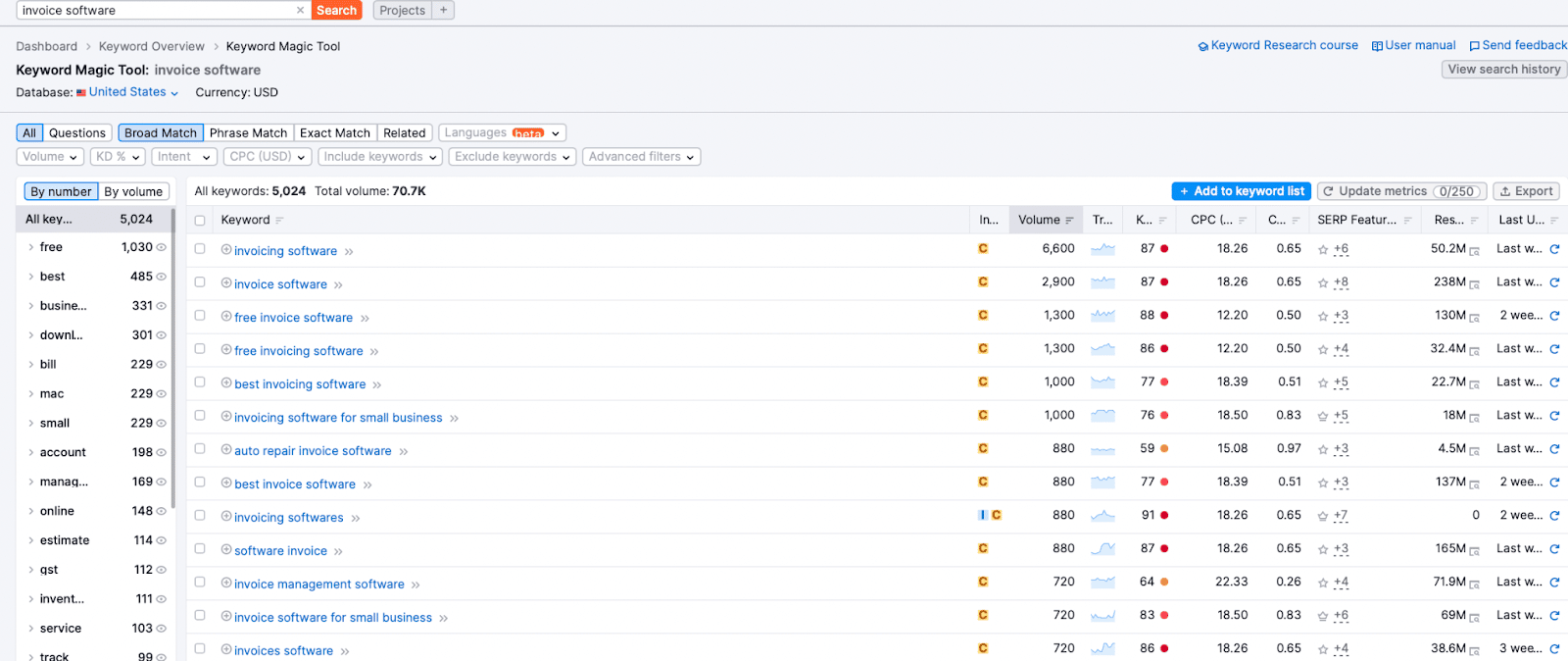
See what pops up during these searches. The top sites dominating both the ad and search results are those putting time and energy into campaigns to rank for those specific results.
You can also check out review-based posts like “best invoicing software for small businesses in 2022,” which can give you a quick breakdown of who your competitors are and what they offer.
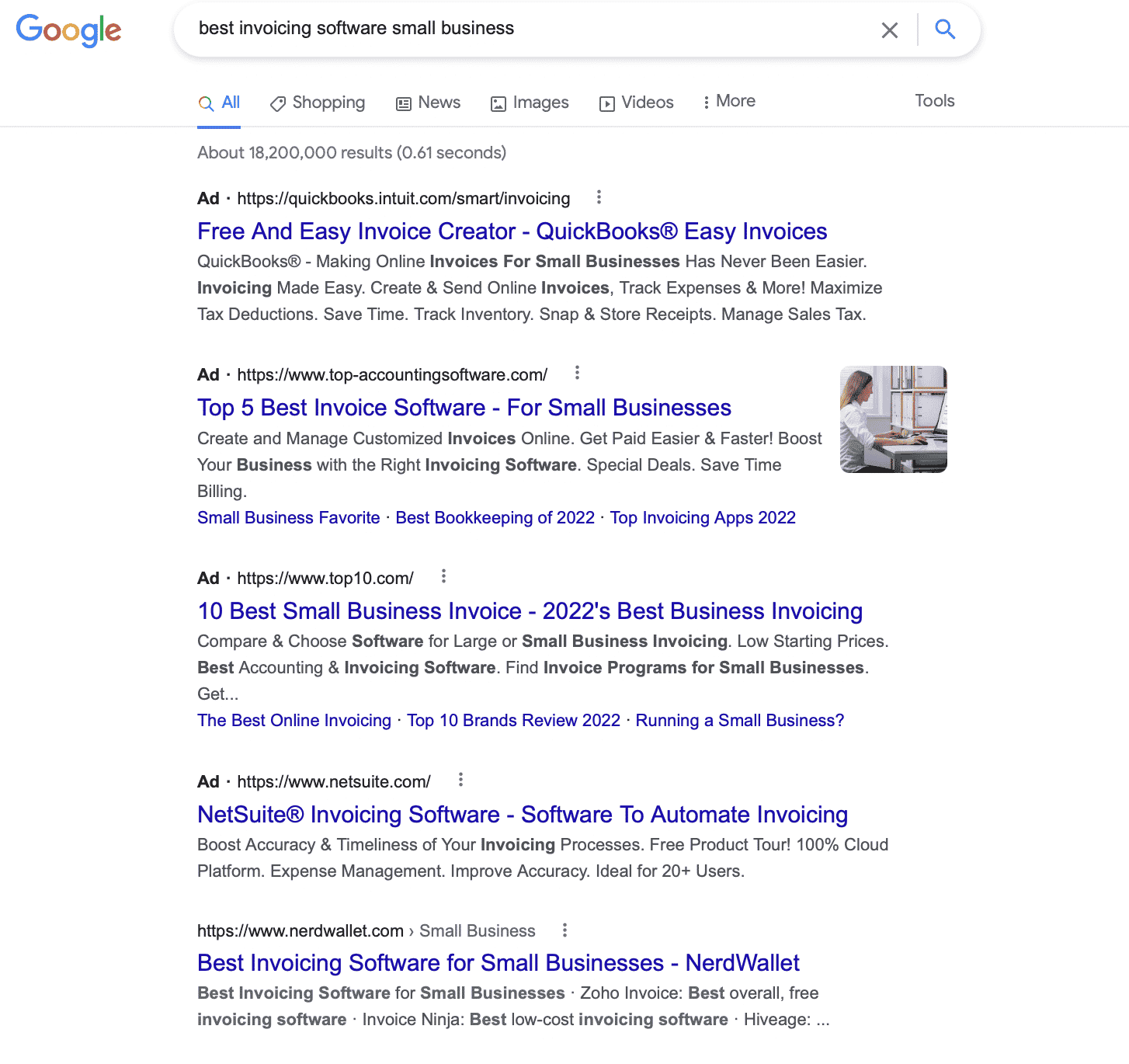
At this stage, make a list of the competitors that you’re finding. Read customer reviews, check out the business’s sites, and look at their core USPs and key features. This can help you determine if they’re direct, indirect, or potential competitors.
3. Dive Into Social Media
Social media is a great place to learn more about your competitors. This is where you’ll see a brand’s “authentic” voice shine through.
You can see how they’re marketing themselves, and who they’re marketing to— and, just as important, how those audience members are responding.
Let’s look at an example. Wave HQ is an indirect competitor of Quickbooks due to the fact that they’re largely targeting businesses with no more than nine employees.
This is easy to see based on their Facebook account, where they’re clearly targeting subscribers who may be newer to the business world. You can see this in the post below, where they define “retained earnings” and provide resources on their blog to explain more.
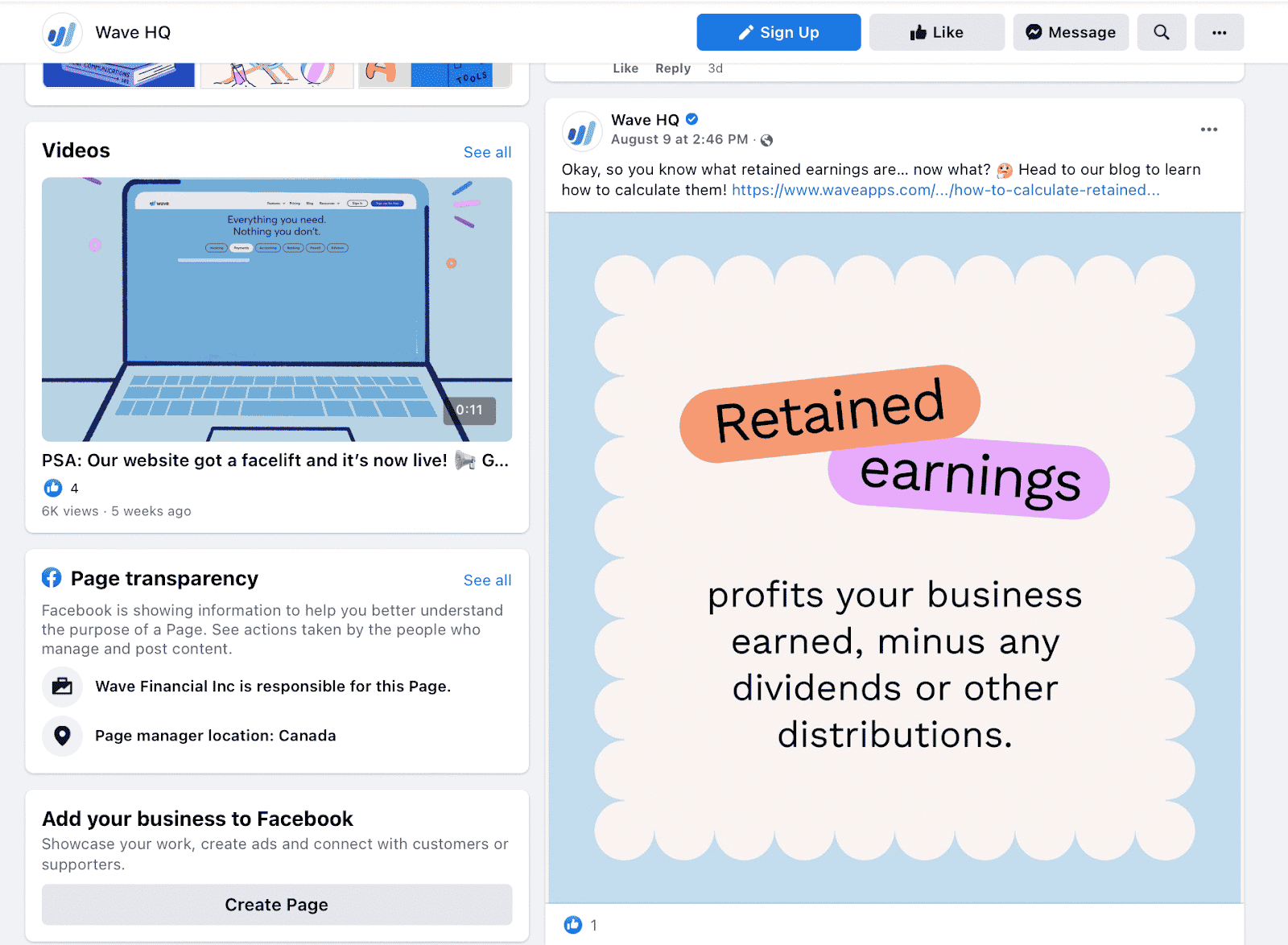
This information may seem minor, but it can ultimately be wildly significant. You can learn a great deal about the types of content each individual competitor is sharing, including what “level” of user they seem to be targeting.
It’s clear who is primarily targeting enterprise clients compared to single-member LLCs, for example, on social media— even if it’s more difficult to spot on their site if they have multiple different product pages geared to each audience segment.
4. Consider Using Third-Party Research Tools
If you’ve got a basic list of competitors but think you may still be missing a few, consider turning to third-party competiåtor research tools.
There are a few great ones on the market, including the following:
- SpyFu can help you see which competitors are bidding on or ranking for the same keywords you’re targeting (both organic and PPC)
- Semrush market explorer has outstanding market industry research tools that are designed to help you identify different competitors in the market and how you’re performing against them, including media competitors (pictured below)
- Owletter monitors and stores your competitors’ emails so you can get detailed insight into their core messaging strategy and who their audience is
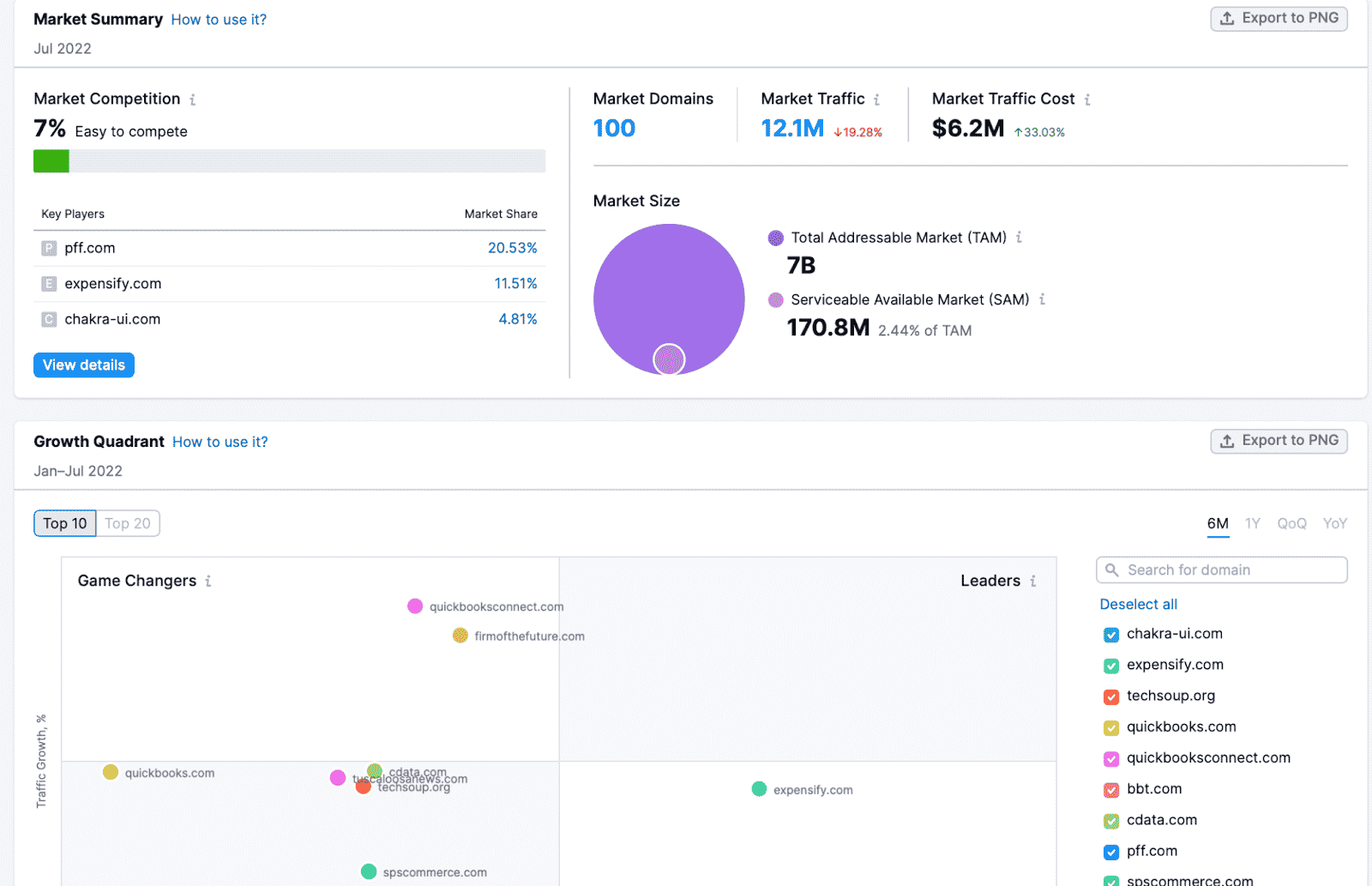
There are third-party tools to monitor a number of different online platforms, including SEO activity, social media activity, and more. If you don’t want to look into each platform manually, consider using these tools to fill in the gaps and learn more about how your competitors are functioning and who they’re selling to.
Final Thoughts
Competitor research should be a priority for every SaaS business. You need to understand who you’re up against if you want to ensure that you’re positioning your own brand correctly and competitively.
Sometimes, seeing what the competition is doing is even a great way to discover what you can do to make your own offerings unique.
As you’re conducting competitor research, sort competitors into different categories of direct, indirect, and potential competitors so that you can analyze them correctly. This is the best way to gather accurate and actionable insight that you can use moving forward.
Once you’ve finished the mapping, it’s time to write your competitive battle cards to keep track of them and empower your sales team to address any competitors’ related questions.
Want to learn more about competitor analysis? Check out our competitor analysis guide here.


